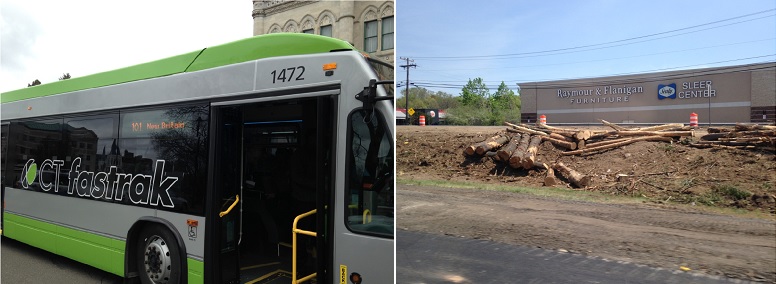CTfastrak and the widening of Interstate 84 in Waterbury have a lot in common. They’re both major transportation projects aimed at improving mobility, both became visible to the traveling public in the spring of 2015, and both cost hundreds of millions of dollars.
One key difference: it seems that the Connecticut Department of Transportation is being asked to justify the amount it’s spending on the bus rapid transit service, while spending on major highway projects seems to be accepted without much media scrutiny.
The Hartford Courant reported this week that the state subsidy for operating CTfastrak will be 75 percent greater than what ConnDOT had originally proposed:
When transit planners decided to open CTfastrak with more service than originally proposed, they also drove up the yearly cost to taxpayers — by 75 percent.
The state subsidy for the new busway is now pegged at $17.5 million for the first year of service.
That’s $7.5 million more than the $10 million-a-year estimate that the DOT had cited for many years before CTfastrak opened in late March.
It’s a substantial increase, but that original subsidy estimate is eight years old (though ConnDOT Commissioner Redeker probably shouldn’t have been “quoting the $10 million figure with no caveats or disclaimers” as recently as 2014 — good sleuthing by the Courant). Since then, ConnDOT had expanded its service plan, which makes the system more useful and convenient, which in turn drives up ridership. And it’s working. Average daily ridership, according to the same article, is over 16,000, about 50 percent higher than the expected 11,200 daily riders.
Then, this morning, the Courant published an editorial which calls for more transparency not just on CTfastrak costs, but also on how the bus rapid transit system has impacted highway congestion and why there appears to be a parking shortage at station areas. While we don’t disagree that ConnDOT (or any other government agency) ought to be more transparent, we have to wonder why the Courant, and really, the mainstream media in general, haven’t been nearly as scrupulous about highway projects.
Which brings us back to the widening of Interstate 84 in Waterbury.
We live in a country where transit is expected to turn a profit while roads supposedly pay for themselves. So we shouldn’t be surprised to see that this level of scrutiny has evaded the discourse surrounding the 2.7 mile widening, a project that is intended to unclog an infamous bottleneck. When the project got underway last April, did anyone ask how it was being paid for, or whether lower-cost strategies could steer local traffic away from I-84, or how ConnDOT justified the project using an environmental assessment that was completed in the 1990s, or why the project would cost hundreds of millions when the American Road and Transportation Builders Association says expanding a four lane interstate to six lanes costs roughly $4 million per mile?
Of course not. More than 78 percent of Connecticut commuters (and an astounding 81 percent of metro Hartford commuters) drive to work alone, compared to less than 5 percent who ride transit. And these numbers don’t just tell us how people in Connecticut get to work; they also tell us something about the perspective from which Nutmeggers view the world: No more bottleneck? By any means necessary! More money to subsidize bus riders? Let’s see your numbers.
The Courant‘s editorial board is right to call on government agencies to be more forthcoming, but when you pore over the details of transit spending, while giving multi-million dollar highway projects a pass, you’re not telling the whole story.


[…] station seems to be blaming the death of a cyclist on the state’s 3-foot passing law. And the Tri-State Transportation Campaign laments that highway projects aren’t subject to the same level of scrutiny as transit […]
I would just make the observation that if instead of paving over the rail right of way from Newington to New Britain, maybe we could have done Commuter, intercity and freight rail from Hartford to Waterbury and beyond – obveating the need for I-84 expansion in the Waterbury area :-)
TSTC’s continued bashing of the much-needed I-84 project is insulting to the poor commuters in Waterbury who could really benefit from the safety and congestion improvements that are driving this project. Unfortunately, it’s just not as sexy to planners as the busway, which serves Hartford’s suburbanites.
Again you seem to miss the obvious fact that CTFastrak buses primarily utilize the highway system, including I-84.